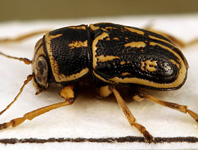Abstract
Formally, Drosophila melanogaster Meigen, 1830 is still Drosophila; however, it just waits for the first formal revision of the genus. On the basis of a 23 : 4 vote, the International Commission on Zoological Nomenclature rejected the proposal (Kim van der Linde et al., 2007) to make an exception to the rules and to switch the type of the genus Drosophila from D. funebris to D. melanogaster in order to retain for ever the name Drosophila melanogaster for the species that represents probably the most important model organism in many branches of biological research. The results of molecular taxonomic studies have shown that the correct name of this species should be Sophophora melanogaster rather than Drosophila melanogaster (O'Grady, 2010; van der Linde et al., 2010). Taxonomists and phylogeneticists are not concerned too much with this as Drosophila/Sophophora melanogaster represents for them just one of many millions of species. The nontaxonomists, i.e., the remaining approximately seven billion inhabitants of our planet, are in a worse situation. When they want to communicate precisely about the fly that eats their fruit, that is a vector of bacterial pathogens in food processing or healthcare facilities, that is a carrier of an interesting gene, or that is considered as the subject of a regulation or a rule to be formulated, they have a problem.

